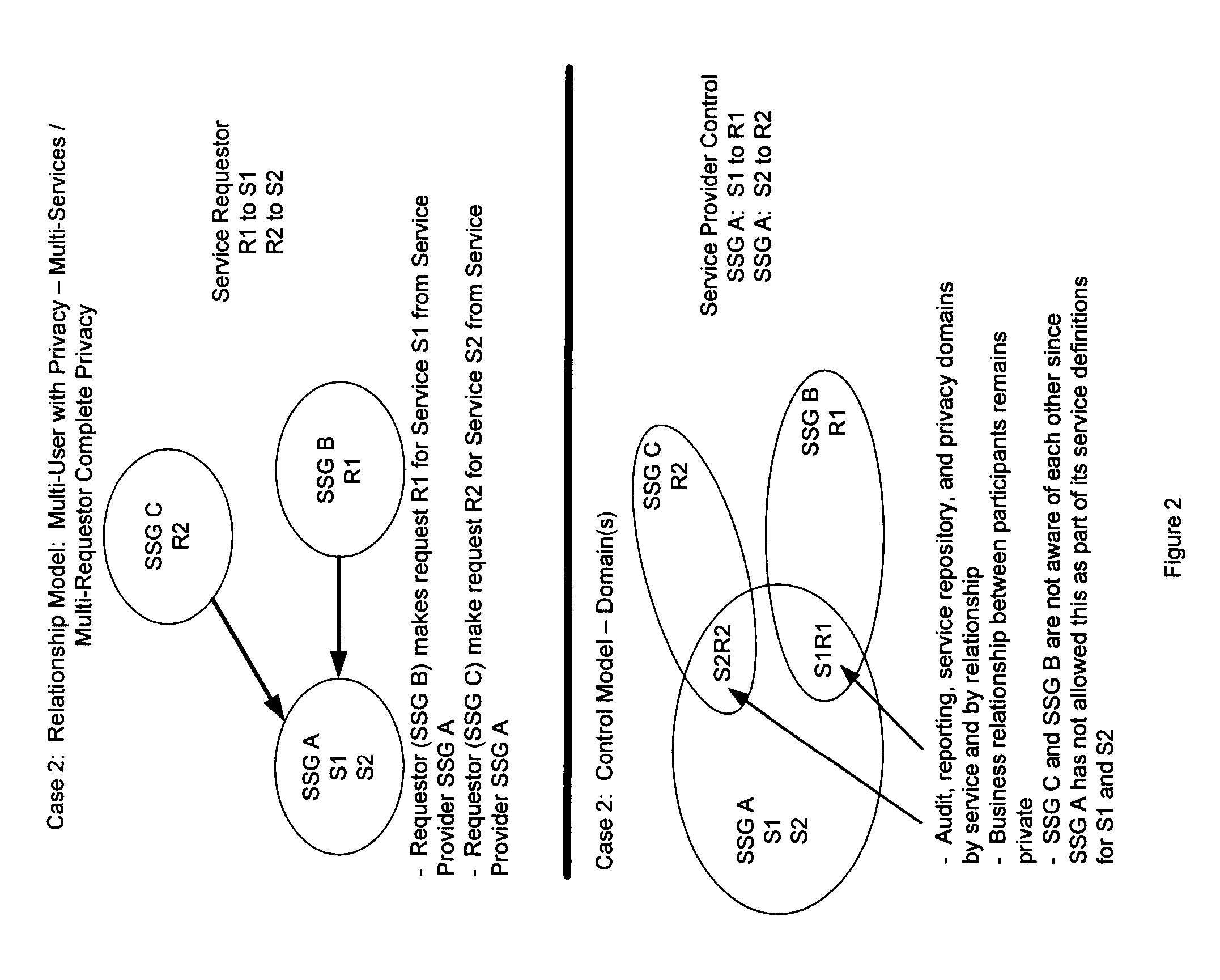Method for creating virtual service connections to provide a secure network
a virtual service and network connection technology, applied in the field of secure electronic information exchange, can solve the problems of increasing the cost of support, increasing the risk of network failure, so as to reduce the value of a competitor's equipment, high-value secure services, and maintaining security and privacy
- Summary
- Abstract
- Description
- Claims
- Application Information
AI Technical Summary
Benefits of technology
Problems solved by technology
Method used
Image
Examples
example 1
Base SSN Relationships Model—Simple Requestor and Service Provider
[0124]FIG. 1 depicts relationship and control models for a simple SSN relationship. FIG. 1A illustrates the base SSN relationship model showing a simple requestor communicating to a service provider, namely, requestor SSG B makes a request R1 for a service S1 from service provider SSG A. This represents an example of a simple VSC for the service S1 provided by SSG A.
[0125]This figure displays a relationship model depicting a simple relationship allowed and enforced by the invention and represents a simple VSC. In this case an SSG A on the SSN is a provider of service S1 to the network and specifically granted access to this service to SSG B. SSG B consumes this service by way of a service request R1.
[0126]The control model for the relationship defined by this service is shown in the figure as the domain of S1R1 where the provider of S1 maintains absolute control even though reporting is a combination of SSG A and SSG ...
example 2
Multi-User With Privacy—Multi-Services / Multi-Requestor Complete Privacy
[0136]FIG. 2 depicts a relationship model with multiple users and a privacy function allowing complete privacy for the multiple services and multiple requesters on an instance of the invention. In the control model the business relationship between participants remains private; SSG C and SSG B are not aware of each other since SSG A has not allowed this as part of its service definitions for S1 and S2 for each requester.
[0137]This figure displays a relationship model depicting a multi-user environment allowed and enforced by the invention. In this case the service provider provides a service to one or more requesters—Requestor (SSG B) makes request R1 for Service S1 from Service Provider SSG A;—Requestor (SSG C) makes request R2 for Service S2 from Service Provider SSG A.
[0138]The control model for the relationship defined by this service is shown in the figure as the domains of S1R1 and S2R2 where the provider m...
example 3
Multi-User With Privacy—Single Service / Multi-Requestor Complete Privacy
[0139]FIG. 3 depicts a relationship model that provides multiple users with privacy when using the same service from a common service provider where complete privacy is maintained for the requesters. The service requesters are shown R1 to S1 and R2 to S1. Requestor SSG B requests R1 for service S1 from service provider SSG A; requestor SSG C requests R2 for service S1 from service provider SSG A.
[0140]This figure displays a relationship model depicting a multi-user environment allowed and enforced by the invention. In this case the service provider provides a service to one or more requestors—Requestor (SSG B) makes request R1 for Service S1 from Service Provider SSG A;—Requestor (SSG C) makes request R2 for Service S1 from Service Provider SSG A.
[0141]The control model for the relationship defined by this service is shown in the figure as the domains of S1R1 and S1R2 where the provider maintains absolute control...
PUM
 Login to View More
Login to View More Abstract
Description
Claims
Application Information
 Login to View More
Login to View More - R&D
- Intellectual Property
- Life Sciences
- Materials
- Tech Scout
- Unparalleled Data Quality
- Higher Quality Content
- 60% Fewer Hallucinations
Browse by: Latest US Patents, China's latest patents, Technical Efficacy Thesaurus, Application Domain, Technology Topic, Popular Technical Reports.
© 2025 PatSnap. All rights reserved.Legal|Privacy policy|Modern Slavery Act Transparency Statement|Sitemap|About US| Contact US: help@patsnap.com



